Answers to Frequently Asked Questions
1) Modular and non-modular origami -- what's the difference?
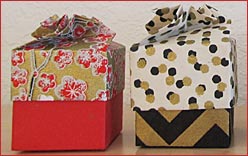
Non-Modular Boxes With Lids |
|
In traditional origami, an object is created by folding a single sheet of paper. The non-modular boxes, bowls, and other containers on this site
were created using this approach.
For each non-modular box with a lid, the base was made from a single sheet of paper and the lid was made from another single sheet of paper. Two examples are shown at left.
For self-closing containers, and for non-modular containers without lids -- like the heart-shaped bowls shown at right -- a single sheet of paper was used to make each container. |
|
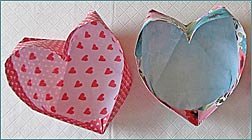
Non-Modular Heart-Shaped Bowls |
In modular origami (also called unit origami), an object is created by assembling two or more modules (or units).
The multiple units are then joined together cleverly without tape or glue, usually by inserting a
tab-like part of one unit into a pocket-like part of another.
The modular boxes on this site required anywhere from 4 to 12 sheets of paper. For example, most of Teresa's modular squares have a
lid made from 4 sheets
and a base made from 4 sheets, as shown by the examples at right.
The modular approach to making origami boxes expands the creative possibilities of this hobby,
since several different types of paper can be combined in one box. Quite often, the same set of units can be assembled in
different ways to produce interesting design variations.
Back to Top
|
|

Modular Boxes With Lids |
2) Who designed the origami boxes, bowls, and other containers shown on this site?
Clicking on the image for any origami item featured on this site will provide you with many details about that item, including the name of the individual who originally designed the
origami model. In most cases, you will also see information about where Teresa found the design -- a book or kit, a PDF on the web, or a video on the web.
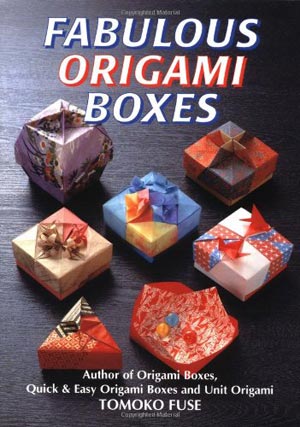
"Fabulous Origami Boxes" by Tomoko Fuse |
|
Most of the boxes, bowls, and other containers shown on this site were constructed by following the instructions in these books by Tomoko Fuse:
- Origami Boxes (Chikuma Shobo Publishing Co., Ltd., 1989) - in English
- Joyful Origami Boxes (Japan Publications Trading Co., Ltd., 1996) - in English
- Fabulous Origami Boxes (Japan Publications Trading Co., Ltd., 1998) - in English
- Hako No Origami 2 (Beautiful Origami Boxes 2) (Nihon Vogue Co., Ltd., 2014) - in Japanese
- Hako No Origami 3 (Beautiful Origami Boxes 3) (Nihon Vogue Co., Ltd., 2014) - in Japanese
- Amazing Origami Boxes (Dover Publications, Inc., 2018) - in English
- Decoration Boxes - Origami Collection (Chikuma Shobo Publishing Co., Ltd., 1991) - in Japanese
- 30 boîte en origami (30 Origami Boxes) by Tomoko Fuse (Les éditions de saxe, 2013) - in French
- Faszinierende Origami-Schachteln (Fascinating Origami Boxes) (Droemer Knaur, 2007) - in German
- Origami Gift Boxes (Japanese Broadcasting Publishers Association, 1995) - in Japanese
- Various Cases and Boxes (Seibundo Shinkosha Publishing Co., Ltd., 2003) - in Japanese
- Making Unit Origami Stylish Accessories (Japanese Broadcasting Publishers Association, 1993) - in Japanese
- Origami Workshop: Origami for a Delightful Table (Seibundo Shinkosha Publishing Co., Ltd., 2007) - in Japanese
- Home Decorating with Origami (Japan Publications, 2000) - in English
- New World 1: Box Freedom 1 (Chikuma Shobou, 1989) - in Japanese
Other designers whose models are shown on this site include: Elena Afonkina, Richard L. Alexander, Simon Andersen, Marc Vigo Anglada, Christiane Bettens (Mélisande),
Evi Binzinger, Christine Blasek (Kalami), Mark Bolitho, Phillip Chapman-Bell (Ochene), Kazukuni Endo, Matthew Gardiner, Ilan Garibi, Robin Glynn, Roberto Gretter, Fumio Inoue, Ayako Kawate, Laura Kruskal, Govind Kulkarni, Hedi Kyle, Michael G. LaFosse, Grace Matthews, David Mitchell, Yoshihide Momotani, John Morin, Mari Ono, Chrissy Pushkin (Paper Kawaii), Nick Robinson, Jane Rosemarin, Darren Scott, Jeremy Shafer, Ancella Simoes, Maria Sinayskaya,
Sweet Paper, Florence Temko, Leyla Torres, Arnold Tubis, Antje Vagt, Jannie Van Schuylenburg, Margaret Van Sicklen, Dennis Walker, Ulla Warchol, Makoto Yamaguchi, and Akiko Yamanashi.
In addition, a few traditional origami designs have been used. These are not attributed to any specific designer.
For details about books and kits referenced on this site, including where to find them on the web, use these links:
|
| Books | Kits |
Back to Top
|
3) Who designed the origami butterflies shown on this site?
The origami butterflies decorating the lids of some boxes on this site were constructed by following the instructions in
Michael LaFosse's Origami Butterflies: Elegant Designs
from a Master Folder by Michael G. LaFosse and Richard L. Alexander (Tuttle Publishing, 2013).
For more details about this book, click here.
Back to Top
|
|
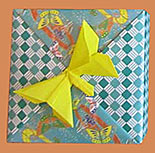
Butterfly Decoration |
4) Why are there no origami diagrams/instructions on this site? Where can I find some?
Most of the boxes shown on this site were made by following diagrams/instructions from copyrighted books or materials. Without permission from the copyright holder, these diagrams/instructions
can not be published here. In the future, it may be possible to get the needed permission -- at least for some of
the origami models.
Meanwhile, this site provides many links to other web sites which offer diagrams/instructions or video tutorials for making origami boxes, bowls, and other containers.
Click on the image of any item displayed on this site to access more details about that particular item. In many cases, those details will include useful links to other sites.
We are currently working on developing a Model-Specific Links Page, so that all of the useful links scattered around our web site will be organized in one place for your convenience.
We hope to add this new page to our site soon. (Note our External Links Disclaimer)
Back to Top
5) Who folded and constructed the origami items shown on this site?
All of the boxes, bowls, and other containers shown on this site were hand-folded and constructed by Teresa Ritter.
She also folded the butterflies which decorate some of the boxes.
After a 25+ year career as a Human Resource Management professional, followed by 10 years as a self-employed web site designer
and developer, Teresa is now enjoying her retirement and the leisure time it gives her for pursuing various hobbies.
Making origami boxes is a very rewarding activity for her.
Deciding how to combine different colors, patterns, and textures of
paper provides a stimulating creative challenge, while the actual folding induces a Zen-like sense of calm.
Teresa hopes that you will enjoy viewing the boxes on this site as much as she enjoyed making them.
Back to Top
6) What types of paper went into making these items? Where did the paper come from?
|
By clicking on the image of any item displayed on this site, you can access detailed information about the type of paper used to make that particular item. In most cases,
you will also find a link to an online source for that paper. (See our External Links Disclaimer)
Kami and Duo Kami, Japanese washi (kozo) and momigami, foil, TANT, rice paper, Nepalese lokta and other mulberry papers, craft paper, letterpress paper, scrapbooking paper in
pads, open stock scrapbooking paper, gift wrap, money, old calendars -- Teresa has folded them all!
Double-sided paper has almost always
been used for those origami models which reveal both sides of the paper.
The quality of the paper used ranges from inexpensive machine-made origami paper, purchased in value packs from craft stores, to expensive sheets of silk-screened Yuzen Chiyogami Washi, imported from Japan and
ordered online from specialty paper sellers.
For an excellent but quick guide to different types of origami paper, visit: https://origami.me/paper/*
For links to more information about paper, click here.
|
|
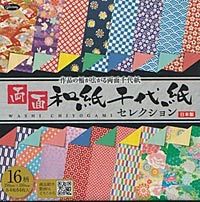
Double-Sided Chiyogami Pack |
Special Note About Using Scrapbooking Paper
It is more difficult to create origami boxes from scrapbooking paper than from origami paper. The thickness and stiffness of most scrapbooking paper make the sheets harder to fold than
origami paper, especially when many small, precise creases are required for a particular style of box. Modular units made with scrapbooking paper may not fit together well due to their bulkiness.
Non-modular boxes made with scrapbooking paper may show breakthrough at the intersection of creases.
Despite these issues, working with scrapbooking paper can be fun and the boxes which result will usually be sturdier than boxes made from origami paper.
Back to Top
7) What sizes and shapes of paper went into making the items on this site?
By clicking on the image for any item displayed on this site, you can access detailed information about the number, shape, and size of the sheets used to make that particular item. You will
also see the overall size of the finished item.
Sheet Shapes
Most of the modular items featured on this site require square sheets, although a few require rectangular sheets, which can easily be cut from squares.
Some of the non-modular items featured on this site require square sheets, but many require rectangular sheets, and a few require sheets shaped like pentagons,
hexagons, or octagons, which can be obtained by folding and cutting square sheets.
Sheet Sizes
Various types of origami paper are sold in square sheets of the following sizes: 21 cm (about 8 1/4 in), 15.2 cm (6 in), 15 cm (about 5 7/8 in), 11.75 cm (about 4 5/8 in),
10 cm (about 4 in), and 7.5 cm (about 3 in). Teresa has used all of these sizes at one time or another.
Japanese washi paper can be purchased online in very large sheets or rolls and then cut as needed. In this way,
Teresa has obtained and used rectangular sheets ranging in size from A4 (21 x 29.7 cm, about 8.3 x 11.7 in) all the way up to A1 (23.4 x 33.1 cm, about 23.4 x 33.1 in)
and even larger.
For more information about where to buy origami paper online, click here.
Scrapbooking paper is usually sold in these sizes: 12 in (30.5 cm) square, 8 1/2 x 11 in (21.6 x 27.9 cm), 8 1/2 in (21.6 cm) square, and 6 in (about 15 cm) square.
Experimenting with Different Sheet Sizes
Often an origami designer will recommend a specific sheet size in his or her instructions, but it may be possible to alter the sheet size, thus changing the dimensions
of the finished model. Experimenting with different sheet sizes can be fun.
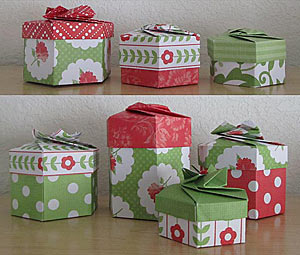
Non-Modular Hexagons: Same Base Made With
Different Sizes of Rectangular Sheets |
|
For example, all of the boxes shown at left have the same style of base -- a non-modular hexagonal base designed by Tomoko Fuse. However, you will notice quite a bit of variation in the height and width of these boxes.
The different heights and widths were achieved by using rectangular sheets of varying dimensions. Click for details
The image at right shows a set of three modular square boxes which can be nested or stacked. The large box was made with 19 cm (7 1/2 in) square sheets, the medium box was made with 15.25 cm (6 in) square sheets,
and the small box was made with 11.4 cm (4 1/2 in) square sheets. Sets of this type are easy to create. Click for details
|
|
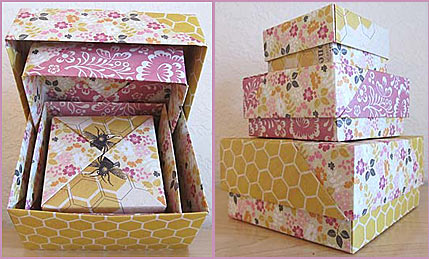
Modular Square Boxes - Nested/Stacked Set |
Back to Top
8) How can origami boxes, bowls, and other containers be used in a practical way?
Origami boxes, bowls, and other containers are beautiful as decorative objects, but they can also serve many practical purposes.
An origami box makes a great container for a small gift, and many recipients will consider the box itself
to be a wonderful gift. Also, why not replace your store-bought gift bags with beautiful hand-folded origami gift bags?
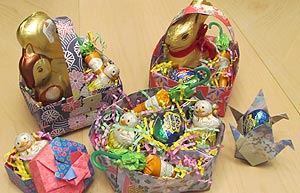
Origami Easter Baskets and Boxes |
|
In your office, origami boxes can hold postage, receipts, paper clips, erasers, thumb tacks,
sticky-note pads, thumb drives, batteries, etc. In your home, use them to store almost any type of small personal item: loose change, keys, coupons, buttons, needles, thread,
sewing pins, jewelry, lip gloss, hair pins, pills, manicure set, etc.
Origami bowls can be used to serve snacks at parties. Small boxes, bowls, and treat sacks can be filled with candies and used as party favors.
Many origami items are perfect for celebrating the holidays: heart-shaped boxes for Valentine's Day, flower-shaped bowls for Mother's Day, or star-shaped containers for New Years.
Next Easter, why not put all your eggs in one origami basket?
The number of practical uses for origami items is limited only by your imagination. Once you start making origami boxes, bowls, and other containers, you will discover more and
more ways to enjoy them for both their beauty and their utility.
|
Back to Top
9) What did Teresa do with all these origami items? Where did they end up?
Some of the items shown on this site were given to Teresa's relatives and friends as gifts. Some are still being used in her home, especially at the holidays.
The vast majority of Teresa's origami boxes, bowls, and other containers were given away at small craft fairs to raise funds for non-profit organizations. Some of the groups to which Teresa has
donated her fundraiser proceeds include:
- Valerie's House (FL - youth grief counseling center)
- ChildFund Internationa (India and Brazil)
- Peace River Wildlife Center (FL)
- Gulf Cove United Methodist Church (FL - for hurricane damage repairs)
- Florida Disaster Fund
- Punta Gorda Garden Club (FL -- for scholarships)
- All Hands and Hearts (FL - for victims of Hurricane Michael)
- Rebuild 850 (FL - post-hurricane assistance)
- Fund for Victims and Families (Marjorie Stoneman Douglas High School shooting, Parkland, FL)
- Sebring Strong Survivors' Fund (SunTrust Bank shooting, Sebring, FL)
- Peace River K-9 Search and Rescue (FL)
- Support Surfside (FL - for victims of tower collapse)
If you would like to learn more about "folding for funds", click here.
Back to Top
|
|
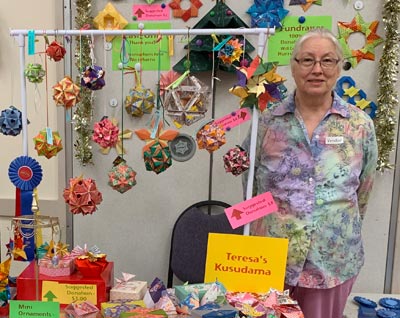 |
10) Does Teresa make any origami models other than boxes, bowls, and containers?

Holiday Star - Door Decoration
|
|
Teresa enjoys using her skills to fold and assemble many different types of origami decorations and accessories. She especially likes to make kusudama -- modular globe-shaped hanging ornaments. (These are sometimes called Japanese medicine balls, flower balls,
floral globes, or modular polyhedra.)
Teresa has recently begun to make a variety of origami wreaths, stars, Christmas tree ornaments, wall hangings, table-top decorations, chopstick wrappers, and other origami accessories.
Click here to see Teresa's kusudama and other origami ornaments/decorations/accessories
Back to Top
|
11) Has Teresa ever won any awards for her origami?
Teresa frequently exhibits her origami items at the Charlotte County Fair in Florida. She has earned numerous Blue Ribbons, as well as a Best in Show Ribbon.
Click here for more details about awards
Back to Top
|
|
![[Awards for Origami Boxes] [Awards for Origami Boxes]](/AwardImgs/2017awards.jpg) |
|
![[Awards for Kusudama] [Awards for Kusudama]](/AwardImgs/2018awards.jpg) |
12) Does Teresa ever teach any origami classes?
Teresa teaches both a beginner-level origami class and an intermediate-level origami class at the North Port Public Library in North Port, FL.
Click here to learn more*
|
Back to Top
|